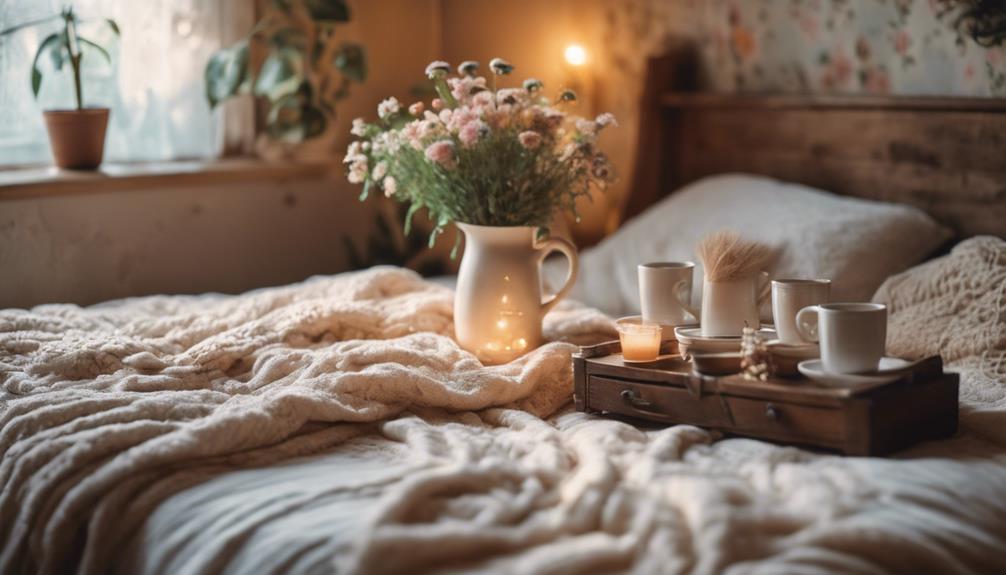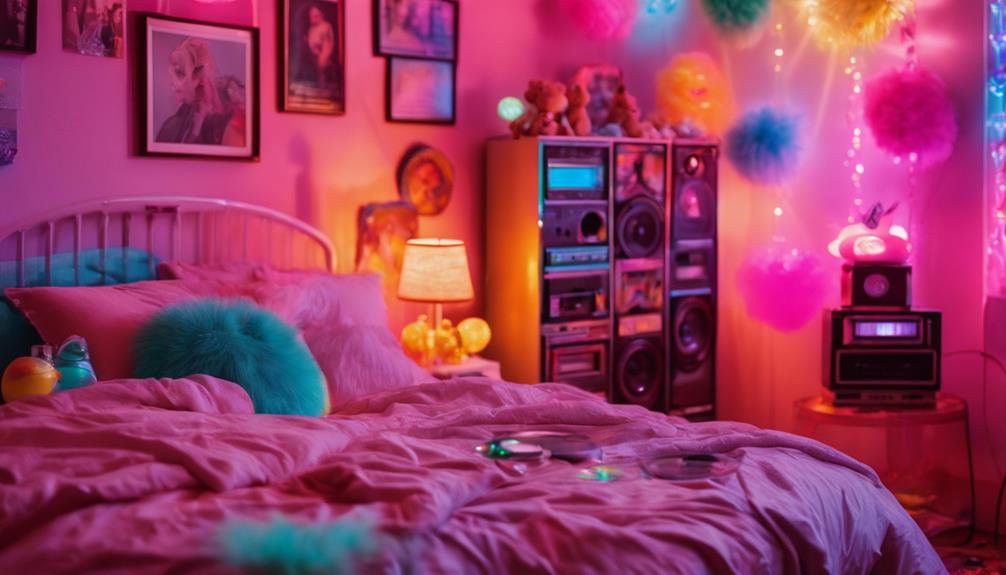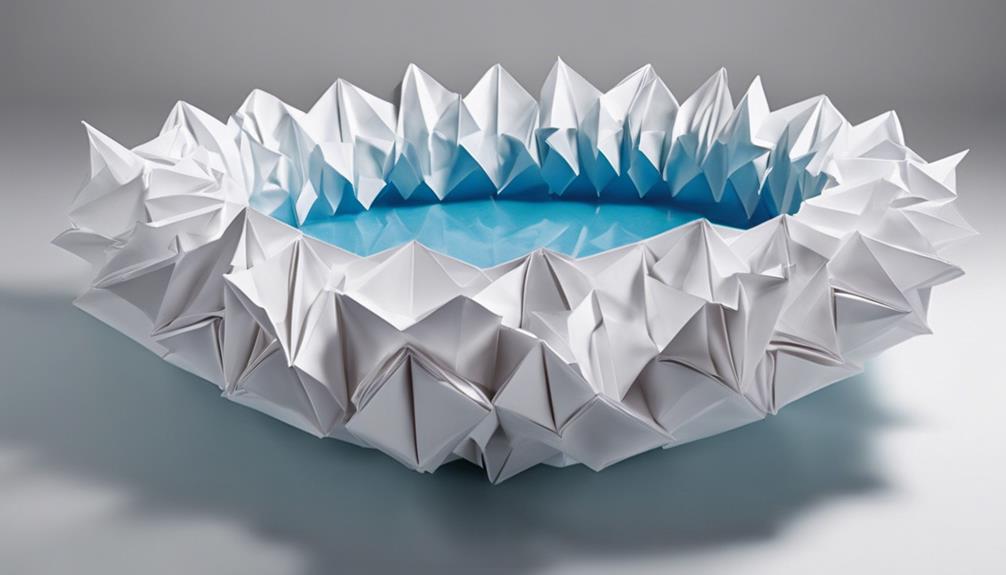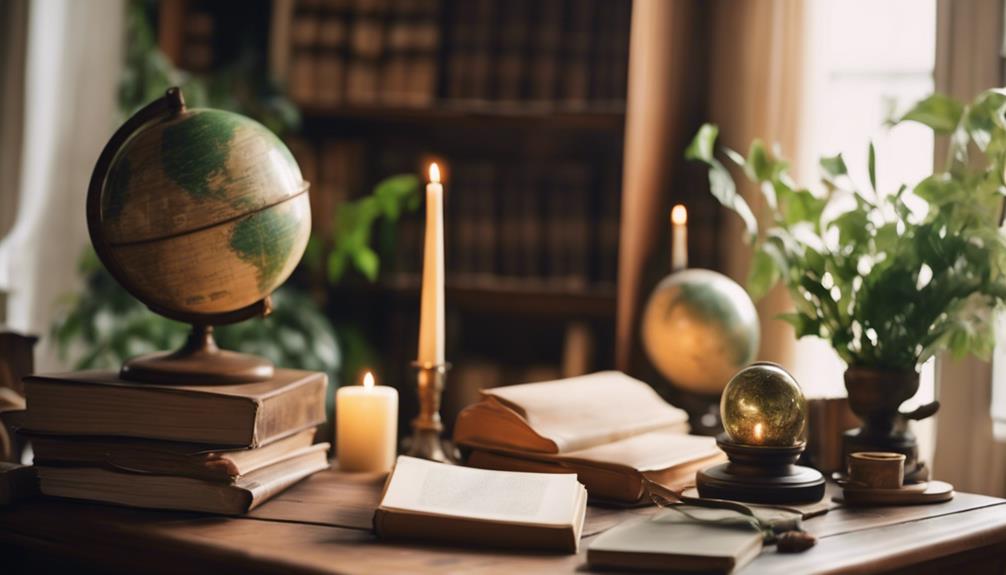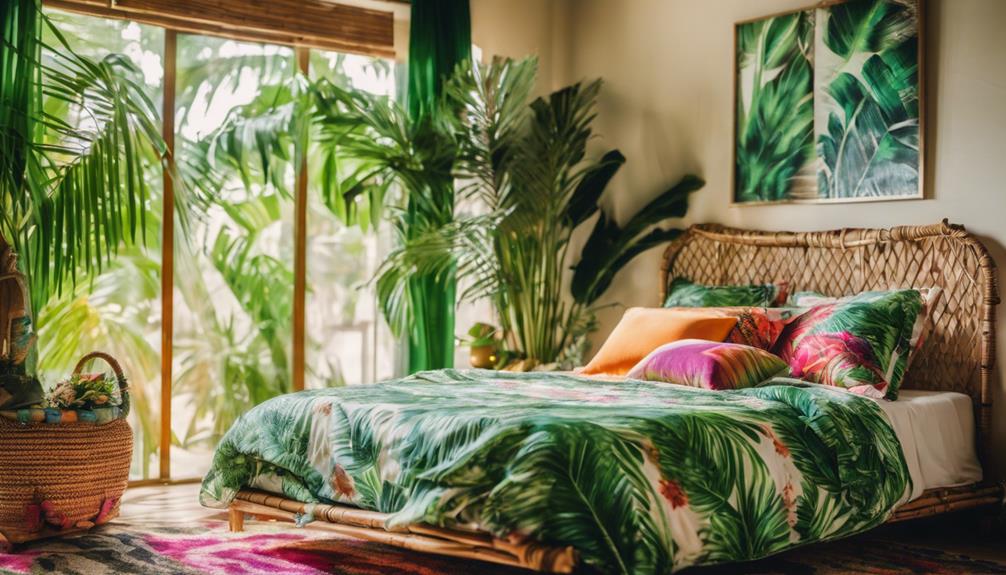Combining aesthetic and cottagecore room decor gives your space a cozy and stylish vibe. Start with soft pastel colors and earthy tones that evoke calmness. Incorporate vintage furniture, like a woven wicker chair or an antique wooden table, to add character. Layer textures with linens, floral cushions, and knitted throws for warmth. Soft, ambient lighting, such as Edison bulb string lights or vintage lamps, enhances the inviting atmosphere. Finish with nature-inspired elements like hand-painted vases and dried wildflowers to bring the outdoors in. Keep exploring for more tips on how to create your perfect cozy retreat!
Key Elements
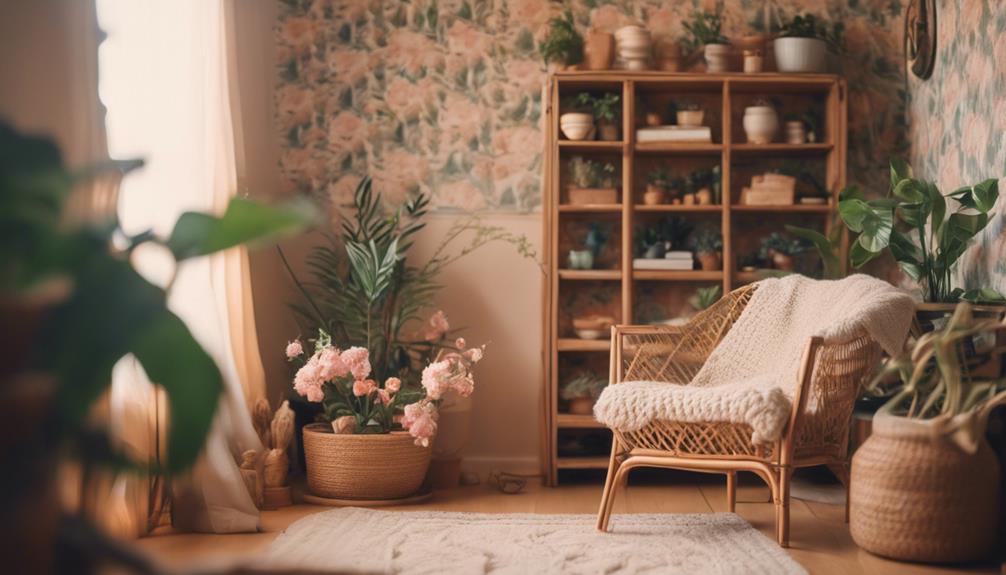
When creating your cottagecore space, pay close attention to the color scheme, materials, and textures you choose.
Soft pastels and natural fibers can enhance the cozy vibe you're aiming for.
Color Scheme
A cottagecore color scheme features soft, pastel hues like muted pinks, greens, and blues that create a serene and inviting atmosphere. This color palette embodies the essence of the cottagecore aesthetic, drawing inspiration from nature and the charm of rural life.
To enhance your space, incorporate floral patterns in textiles, wallpapers, and decor. These whimsical elements add character and warmth, making the environment feel cozy.
Don't forget to balance your muted colors with earthy tones, such as warm browns, beiges, and creams. These grounded shades promote a rustic feel, emphasizing natural materials in your decor.
Layering colors through various textures—like knitted throws, lace curtains, and embroidered cushions—adds depth and visual interest to your room.
You can also introduce accent colors inspired by seasonal changes. For instance, consider soft yellows for spring or deep reds for autumn. These subtle touches create a dynamic yet harmonious space that reflects the beauty of nature throughout the year.
Materials
Natural materials like wood, stone, and linen are essential in creating the warm and rustic atmosphere that defines cottagecore decor.
When you choose furniture, opt for vintage pieces like antique tables and chairs. These not only add character but also enhance the cozy vibe of your space.
For comfort, incorporate soft textiles such as quilts, knitted throws, and floral cushions. These elements invite relaxation and provide layers that make your room feel inviting.
Don't forget that greenery is crucial; houseplants and fresh flowers enliven your space and strengthen the connection to nature that cottagecore emphasizes.
To complete your aesthetic, consider using pastel color palettes and floral motifs in your fabrics and wallpapers. This approach creates a calming ambiance, reinforcing the romanticized and whimsical qualities of cottagecore decor.
By thoughtfully selecting natural materials, vintage furniture, soft textiles, and greenery, you'll create a harmonious environment that embodies both comfort and style.
Your space will feel like a cozy retreat, blending the best of cottagecore with your unique aesthetic.
Textures
Layering various textures is essential in cottagecore decor, creating a warm and inviting atmosphere that draws you in. To achieve this cozy feel, mix materials like soft linens, knitted throws, and rustic woods. These natural materials not only enhance comfort but also connect you to nature, making your space feel more alive.
Incorporating different fabric patterns, like floral and gingham, adds visual interest while maintaining the aesthetic's charm. You can also introduce accents such as wicker baskets and woven rugs, which contribute depth and character to the room.
Vintage lace can act as a delicate touch, further promoting that nurturing ambiance.
Essential Fixtures and Furniture
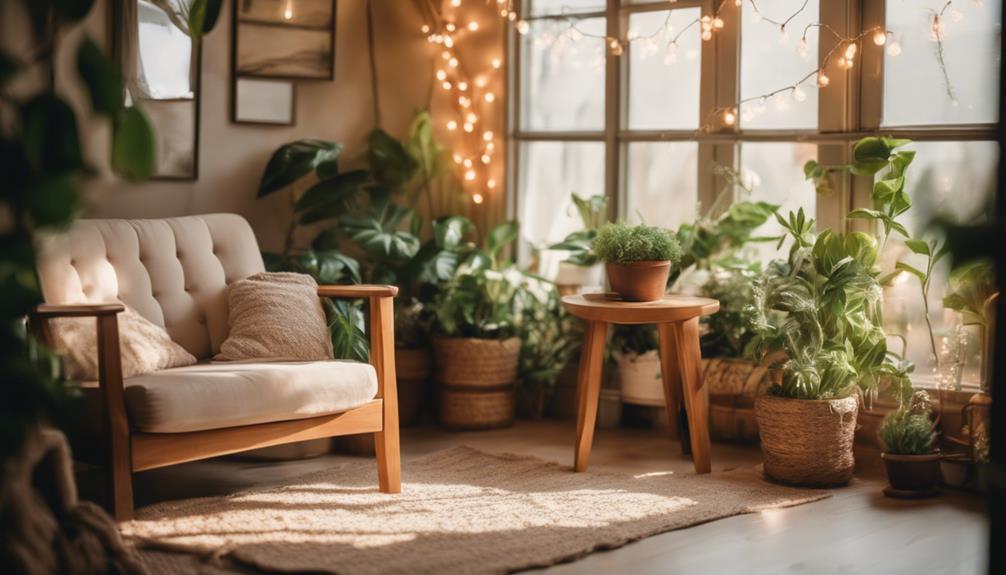
To create a truly inviting cottagecore space, you'll want to focus on essential fixtures and furniture.
An antique wooden dining table serves as a beautiful centerpiece, while a woven wicker armchair adds comfort and charm.
Don't forget to include a vintage floral table lamp, as it enhances the cozy atmosphere and ties everything together.
Antique Wooden Dining Table
Embracing the charm of an antique wooden dining table instantly transforms your space into a cozy cottagecore haven. This centerpiece not only embodies rustic charm but also adds warmth to your dining area, making it the perfect spot for family gatherings and special dinners. The rich textures and unique imperfections of vintage wood enhance the cozy atmosphere, inviting you to sit down and enjoy a meal.
When choosing your antique wooden dining table, look for one with a distressed or weathered finish. This complements the lived-in aesthetic of cottagecore design and creates a focal point that draws the eye. You'll find tables in various styles, from farmhouse to Victorian, allowing for personalization that reflects your unique taste.
To elevate the overall aesthetic, pair your table with vintage tableware and natural centerpieces, like fresh flowers or seasonal produce. These elements not only enhance the beauty of the table but also reinforce the cozy and inviting vibe of your dining space.
With the right antique wooden dining table, you create an atmosphere that feels both stylish and timeless, perfect for enjoying life's simple pleasures.
Woven Wicker Armchair
A woven wicker armchair instantly brings rustic charm to your cottagecore decor, offering a cozy seating option that harmonizes beautifully with natural materials. These armchairs are lightweight, making them easy to reposition, so you can create inviting nooks for reading or relaxing. Their timeless appeal allows them to blend seamlessly with vintage elements and modern pieces alike, enhancing the overall aesthetic of your space.
The open weave of the wicker not only adds texture but also promotes airflow, keeping the chair comfortable during warmer months. This feature contributes to a cozy atmosphere, inviting you to curl up with a book or sip tea while enjoying the natural light streaming in.
When you incorporate a woven wicker armchair into your room, it enhances the nostalgic feel of cottagecore decor, reminding you of simpler times spent in nature. Whether you place it in a sunlit corner or beside a window, the woven wicker armchair will become a cherished focal point, adding both function and style to your cozy sanctuary.
Embrace this essential fixture to elevate your cottagecore aesthetic!
Vintage Floral Table Lamp
The vintage floral table lamp stands out as a charming addition to your cottagecore decor, blending functionality with romantic aesthetics. Its intricate patterns and soft lighting create a warm atmosphere that invites relaxation. Often crafted from materials like ceramic or porcelain, these lamps feature beautiful floral prints that complement the natural themes prevalent in cottagecore design.
When you incorporate a vintage floral table lamp into your space, it becomes a focal point that enhances both style and coziness. The unique shapes and colors of these lamps allow them to blend seamlessly with other home goods, such as antique furniture and soft textiles. Imagine placing your lamp on a side table next to a stack of vintage books, enhancing the inviting ambiance of your room.
As you select the perfect lamp, consider its size and scale to guarantee it fits harmoniously within your cottagecore look. A well-chosen vintage floral table lamp not only illuminates your space but also adds a touch of whimsy and nostalgia, perfectly embodying the essence of your cozy, stylish retreat.
Lighting Ideas
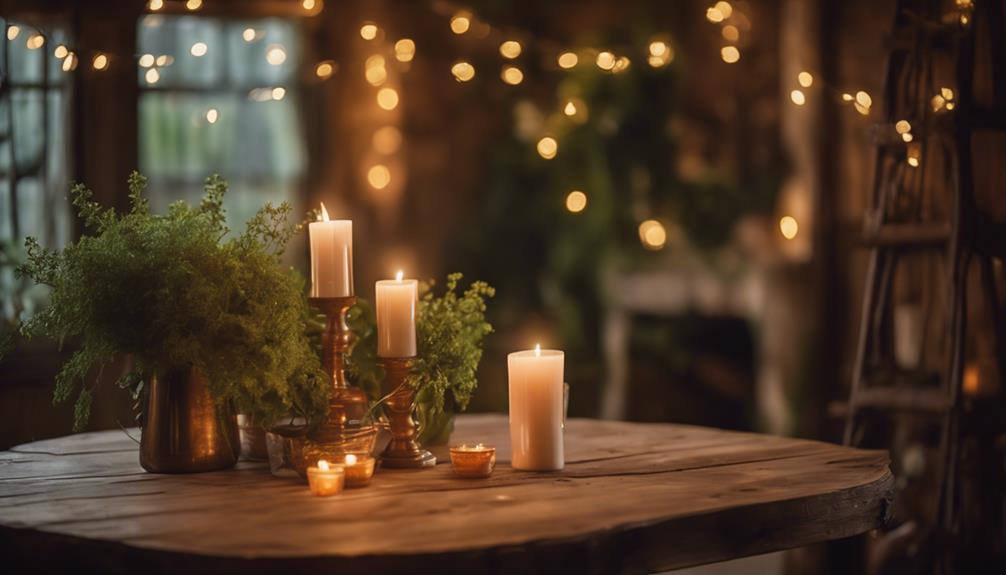
When it comes to lighting your cottagecore haven, you've got plenty of charming options.
Think Edison bulb string lights for a cozy glow, or an antique brass chandelier for a touch of elegance.
Vintage lanterns and soft candle arrangements can also add warmth and romance, making your space feel inviting and magical.
Edison Bulb String Lights
Edison bulb string lights instantly create a warm, vintage glow that transforms your space into a cozy cottagecore haven. These charming lights are perfect for enhancing the cozy atmosphere that defines this aesthetic. You can easily drape them along walls, across ceilings, or around windows, adding a whimsical touch that complements vintage furniture and rustic decor.
With their industrial yet nostalgic appearance, Edison bulb string lights seamlessly blend modern and rustic elements, making them a versatile decorating choice. Available in various lengths and designs, you can tailor them to fit any room size or style. Whether you want to create a cozy reading nook or a romantic dining area, these lights can accentuate the charm of your space.
For an even more inviting ambiance, consider pairing Edison bulb string lights with other soft lighting options like candles or lanterns. This combination contributes to a layered lighting effect, adding depth and warmth that makes your cottagecore retreat even more inviting. Embrace the magic of Edison bulb string lights and watch your cozy haven come to life!
Antique Brass Chandelier Fixture
An antique brass chandelier fixture instantly elevates your cottagecore decor, infusing the space with vintage elegance and warmth. The warm tones of brass beautifully complement the soft color palettes typical of the cottagecore aesthetic, enhancing the cozy atmosphere you crave.
When selecting an antique brass chandelier, pay attention to intricate designs and craftsmanship that reflect the historical charm associated with cottagecore style.
Imagine hanging one of these stunning fixtures in your dining area or living room, creating a mesmerizing focal point that harmonizes with other vintage elements like lace curtains and floral patterns. To maximize its impact, consider incorporating dimmable bulbs. This way, you can adjust the lighting to create a magical ambiance perfect for everyday use or special occasions.
As you enhance your space with an antique brass chandelier, you'll find it not only illuminates your room but also enriches the overall aesthetic. It's a simple yet effective way to embrace the cozy, inviting vibe that defines cottagecore decor, making your home a true reflection of your style and personality.
Vintage Lanterns for Warmth
Vintage lanterns bring warmth and rustic charm to your cottagecore space, creating a cozy atmosphere that invites relaxation and nostalgia.
These beautiful pieces, often crafted from brass or wrought iron, offer soft, ambient lighting that enhances your room's character. You can opt for battery-operated or LED candles inside your vintage lanterns, ensuring safety while maintaining that inviting glow.
Hanging lanterns from beams or hooks not only adds to the cozy atmosphere but also elevates the vertical space, crafting a whimsical, fairy-tale vibe in your living area or outdoor setting.
If you display a collection of vintage lanterns on shelves or tables, you're not just lighting your space but also adding a decorative element that reflects your personal style and history.
Choose lanterns with intricate designs or colorful glass to introduce visual interest, perfectly aligning with the cottagecore aesthetic's emphasis on warmth and charm.
Whether you're hosting friends or enjoying a quiet evening alone, vintage lanterns are essential for achieving that cozy, inviting ambiance that defines your cottagecore retreat.
Soft Glow Candle Arrangements
Building on the warm ambiance created by vintage lanterns, soft glow candle arrangements can further enhance the cozy aesthetic of your cottagecore space. By incorporating an assortment of candle sizes and heights, you'll create a visually interesting display that adds depth and warmth, embodying that rustic charm you love.
Consider using vintage candlesticks made of brass or ceramic to tie the look together with other antique decor elements. Arranging your candles on a wooden tray or a vintage plate not only looks charming but allows for easy movement, making it simple to change your setup seasonally.
Layering different candle types—like pillar, taper, and tea lights—will produce a soft, inviting glow that enhances the cozy atmosphere in any room. You might also want to opt for scented candles with natural fragrances such as lavender or vanilla. These scents evoke a sense of relaxation and connection to nature, key elements of the cottagecore lifestyle.
With thoughtful candle arrangements, you can create a tranquil haven that invites warmth and comfort into your home.
Decorative Elements
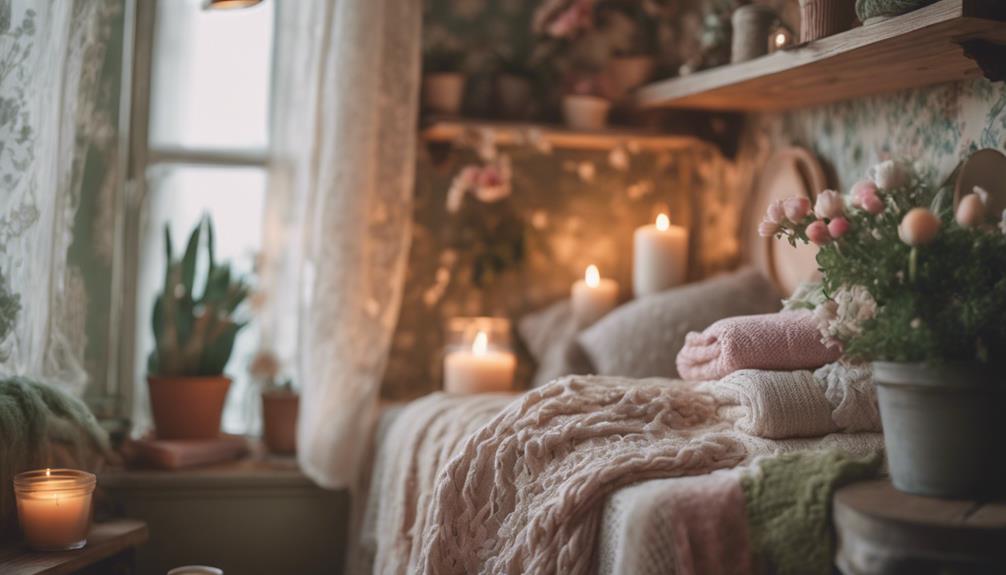
To truly embody the cottagecore aesthetic, you'll want to incorporate decorative elements that reflect nature and craftsmanship.
A hand-painted ceramic vase, a floral embroidered wall hanging, and a dried wildflower bouquet in a jar can infuse your space with personality and warmth.
Each piece adds a unique touch, making your room feel like a cozy retreat.
Hand-Painted Ceramic Vase
Hand-painted ceramic vases add a whimsical touch to your cottagecore decor, showcasing floral designs and soft pastels that enhance the room's cozy charm. These vases are staples in the cottagecore lifestyle, often featuring delightful floral motifs that reflect the beauty of nature.
You can use them as statement pieces on shelves, tables, or window sills, either filled with seasonal blooms or dried flowers, to create a warm and inviting atmosphere.
Incorporating a variety of shapes and sizes of hand-painted ceramic vases brings an eclectic yet harmonious vibe to your space, perfectly aligning with the maximalist approach of cottagecore design. Each unique piece, often crafted using traditional techniques, contributes to the rustic charm that defines this aesthetic.
Thrifting for decor is an excellent way to find affordable hand-painted ceramic vases that embody the imperfect beauty cherished in cottagecore style. Not only does thrifting support sustainability, but it also allows you to discover one-of-a-kind treasures that add character and personal flair to your home.
Embrace these charming vases to elevate your decor and celebrate the cozy, whimsical essence of cottagecore living.
Floral Embroidered Wall Hanging
Floral embroidered wall hangings beautifully complement hand-painted ceramic vases, infusing your cottagecore space with vintage charm and a touch of nature. These exquisite pieces serve as stunning wall decor, showcasing intricate designs that celebrate natural beauty and align perfectly with the cozy cottagecore aesthetic. Featuring blossoms, leaves, and whimsical botanical patterns, they create a focal point that draws the eye and enhances the inviting atmosphere of your room.
You might consider incorporating soft, pastel colors in your floral embroidery to promote a serene ambiance that resonates with the overall palette of cottagecore design. The warmth and artistry of these wall hangings not only add character to your space but also encourage a connection to nature, embodying the essence of a cozy, countryside retreat.
For those who love DIY projects, crafting your own floral embroidered wall hanging can be a rewarding way to personalize your decor. Using thrifted fabrics and sustainable materials, you can create a unique piece that reflects your style while embracing the cottagecore ethos.
Dried Wildflower Bouquet in Jar
Dried wildflower bouquets in jars effortlessly bring the charm of the countryside into your home, creating a warm and inviting atmosphere. These rustic arrangements are a quintessential element of the cottagecore aesthetic, allowing you to blend nature indoors while adding a cozy vibe to any space.
Using a jar as a vase not only enhances the look but also aligns with the cottagecore preference for repurposed and vintage-inspired decor. You can easily find jars at thrift stores or use ones you already have, making this an affordable and sustainable choice. Plus, dried wildflowers require minimal maintenance, perfect for those embracing a slow-paced lifestyle.
The varied colors and textures of dried wildflowers introduce visual interest and warmth, contributing to the layered aesthetic typical of cottagecore design. By incorporating a dried wildflower bouquet in a jar, you create a focal point that captures attention while evoking a sense of nostalgia.
Consider adding some dried herbs alongside the bouquet for an aromatic touch that complements the overall decor. With these simple elements, your cottagecore home will feel both stylish and cozy, inviting everyone to enjoy the beauty of nature within your space.
Flooring
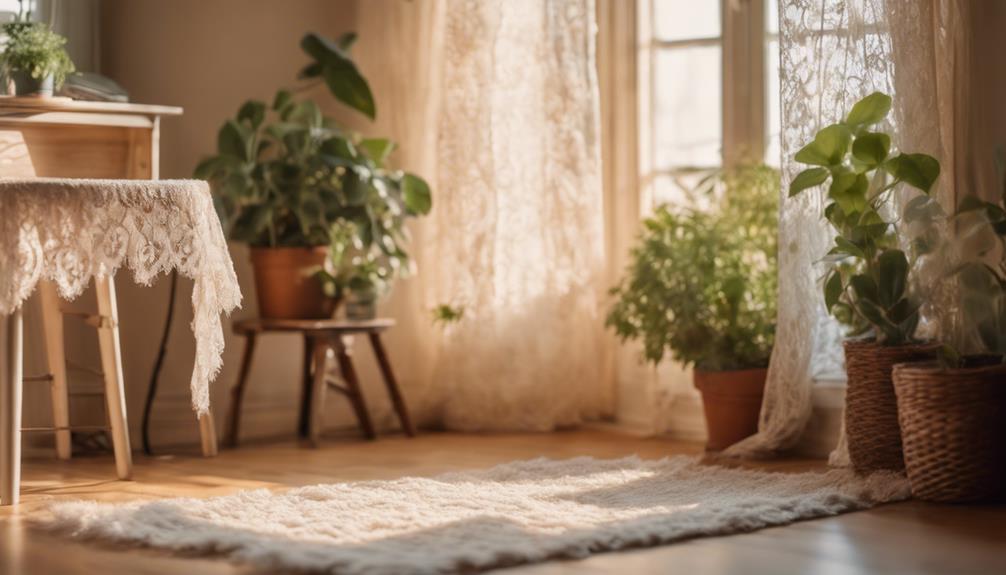
When choosing flooring for your cottagecore aesthetic, think about incorporating reclaimed barnwood planks for that rustic charm.
Vintage-style tiles or cottage-inspired patterned linoleum can add a touch of whimsy and warmth to your space.
Each option not only enhances your decor but also brings a sense of history and comfort to your home.
Reclaimed Barnwood Plank Flooring
Reclaimed barnwood plank flooring brings a rustic charm to your cottagecore space, enhancing its natural and vintage appeal. Sourced from old barns, this flooring option not only celebrates sustainability but also adds unique character with its varied textures and colors. Each plank tells a story, making your home feel more personal and inviting.
The natural aging and patina of reclaimed barnwood contribute to a cozy atmosphere, perfect for curling up with a good book or enjoying a warm cup of tea. This flooring aligns beautifully with cottagecore's emphasis on a lived-in feel, creating a space that feels both comfortable and stylish.
Moreover, installing reclaimed barnwood plank flooring can improve insulation, which may help lower your energy costs. This practical benefit, combined with its aesthetic qualities, makes it an appealing choice for budget-conscious cottagecore enthusiasts.
You'll find that reclaimed barnwood is often more affordable than new hardwood, especially when sourced locally. By choosing this flooring, you're not just enhancing your home; you're also embracing a lifestyle that values history, nature, and sustainability.
Vintage-Style Tile Flooring
Vintage-style tile flooring adds a timeless charm to your cottagecore decor, enhancing the rustic aesthetic with intricate patterns and earthy tones. This flooring choice often features ceramic, porcelain, or natural stone materials that not only boost durability but also introduce a touch of history to your space.
When you opt for encaustic cement tiles with geometric or floral designs, you evoke a nostalgic feel reminiscent of traditional European cottages and farmhouses.
Incorporating vintage-style tile flooring allows you to easily blend with other cottagecore elements, like vintage furniture and natural textiles, achieving a cohesive and cozy decor theme. The warm colors and detailed designs of these tiles create an inviting atmosphere, making any room feel more welcoming.
Plus, maintaining vintage-style tiles is straightforward; just clean them regularly with mild soaps and avoid harsh chemicals to preserve their beauty and longevity.
Cottage-Inspired Patterned Linoleum
Cottage-inspired patterned linoleum flooring brings a charming blend of vintage designs and modern practicality to your home. With floral motifs and checkered patterns, this flooring captures the cozy essence of cottagecore life, enhancing your space's inviting vibe. You'll love how these designs create a warm and whimsical atmosphere, making your home feel like a serene retreat.
Not only is patterned linoleum affordable and durable, but it's also easy to maintain, allowing you to focus on enjoying your cozy sanctuary rather than stressing over upkeep. Available in soft, pastel colors, this flooring can beautifully reflect natural light, adding to the overall charm of your decor.
Moreover, linoleum is an eco-friendly choice, crafted from natural materials such as linseed oil and cork dust. By opting for this sustainable flooring, you align your home with the eco-conscious values of the cottagecore lifestyle.
Installing patterned linoleum can unify your space, providing a charming foundation that complements vintage furniture and decor elements. Embrace the cozy, stylish atmosphere that cottage-inspired flooring offers, and transform your home into a delightful haven.
Conclusion
By blending aesthetic and cottagecore elements, you can create a cozy and stylish space that feels uniquely yours. To achieve this, consider incorporating natural materials such as wood, cotton, and linen into your decor. You can also add touches of nature with potted plants, floral prints, and rustic accents to create a serene and inviting atmosphere. For more cozy living room decor ideas, you can also add soft and plush textiles like throw blankets and pillows to enhance the comfort and warmth of the space.
Embrace soft colors, natural materials, and vintage touches to bring warmth and personality to your room.
Don't forget to experiment with lighting and decorative elements that reflect your style.
With the right fixtures and flooring, you'll craft an inviting atmosphere perfect for relaxation and creativity.
Now, get started on transforming your space into a charming haven!
